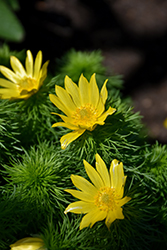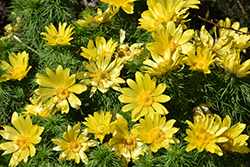Height: 8 inches
Spread: 12 inches
Sunlight:
![]()
![]()
Hardiness Zone: 1
Other Names: Pheasant's Eye
Description:
A lovely, fine textured mounded selection, perfect for garden beds and rock gardens; presenting cheery yellow buttercup flowers nestled on small ferny, compound foliage; slow to establish and summer dormant
Ornamental Features
Spring Adonis has yellow buttercup flowers at the ends of the stems in early spring, which are interesting on close inspection. Its small ferny compound leaves remain light green in color throughout the season.
Landscape Attributes
Spring Adonis is an herbaceous perennial with a mounded form. It brings an extremely fine and delicate texture to the garden composition and should be used to full effect.
This plant will require occasional maintenance and upkeep, and should only be pruned after flowering to avoid removing any of the current season's flowers. It has no significant negative characteristics.
Spring Adonis is recommended for the following landscape applications;
- Mass Planting
- Rock/Alpine Gardens
Planting & Growing
Spring Adonis will grow to be about 8 inches tall at maturity, with a spread of 12 inches. Its foliage tends to remain low and dense right to the ground. It grows at a slow rate, and under ideal conditions can be expected to live for approximately 10 years. As an herbaceous perennial, this plant will usually die back to the crown each winter, and will regrow from the base each spring. Be careful not to disturb the crown in late winter when it may not be readily seen! As this plant tends to go dormant in summer, it is best interplanted with late-season bloomers to hide the dying foliage.
This plant does best in full sun to partial shade. It is very adaptable to both dry and moist locations, and should do just fine under typical garden conditions. It is not particular as to soil type, but has a definite preference for alkaline soils. It is somewhat tolerant of urban pollution. This species is not originally from North America.

